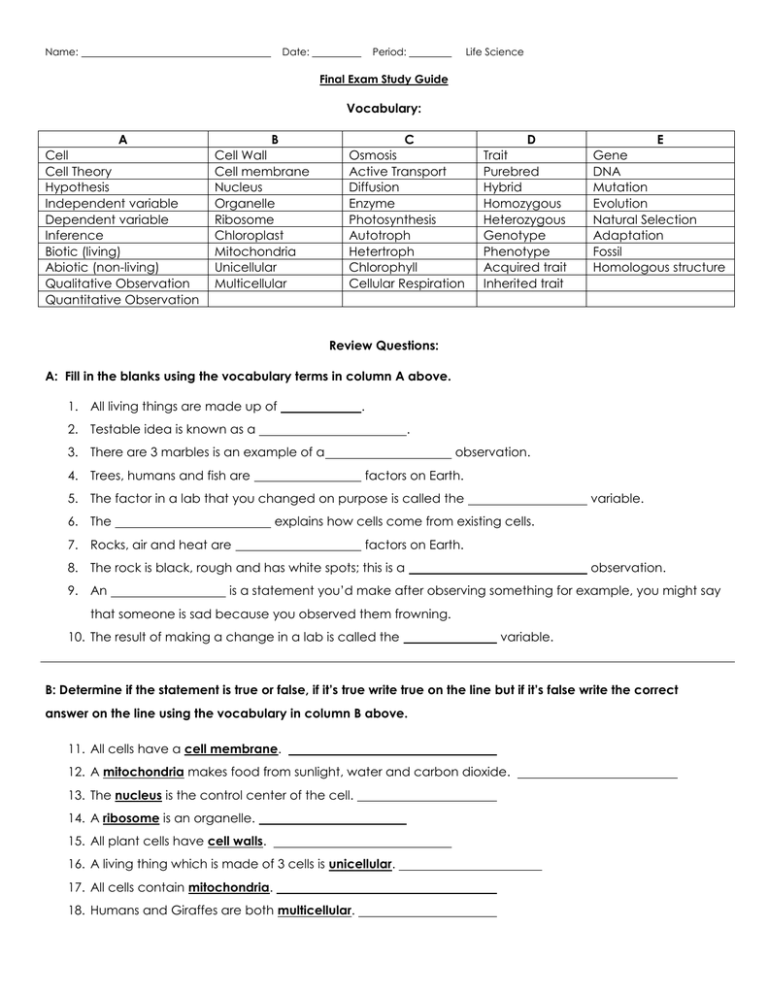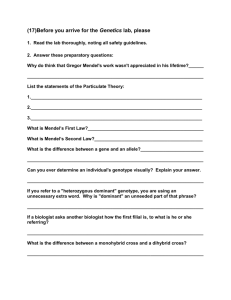Vocabulary: A B C
advertisement

Name: Date: Period: Life Science Final Exam Study Guide Vocabulary: A Cell Cell Theory Hypothesis Independent variable Dependent variable Inference Biotic (living) Abiotic (non-living) Qualitative Observation Quantitative Observation B Cell Wall Cell membrane Nucleus Organelle Ribosome Chloroplast Mitochondria Unicellular Multicellular C Osmosis Active Transport Diffusion Enzyme Photosynthesis Autotroph Hetertroph Chlorophyll Cellular Respiration D Trait Purebred Hybrid Homozygous Heterozygous Genotype Phenotype Acquired trait Inherited trait E Gene DNA Mutation Evolution Natural Selection Adaptation Fossil Homologous structure Review Questions: A: Fill in the blanks using the vocabulary terms in column A above. 1. All living things are made up of . 2. Testable idea is known as a . 3. There are 3 marbles is an example of a 4. Trees, humans and fish are observation. factors on Earth. 5. The factor in a lab that you changed on purpose is called the 6. The variable. explains how cells come from existing cells. 7. Rocks, air and heat are factors on Earth. 8. The rock is black, rough and has white spots; this is a 9. An observation. is a statement you’d make after observing something for example, you might say that someone is sad because you observed them frowning. 10. The result of making a change in a lab is called the variable. B: Determine if the statement is true or false, if it’s true write true on the line but if it’s false write the correct answer on the line using the vocabulary in column B above. 11. All cells have a cell membrane. 12. A mitochondria makes food from sunlight, water and carbon dioxide. 13. The nucleus is the control center of the cell. 14. A ribosome is an organelle. 15. All plant cells have cell walls. 16. A living thing which is made of 3 cells is unicellular. 17. All cells contain mitochondria. 18. Humans and Giraffes are both multicellular. C: Match the vocabulary term above to the example by placing the term on the line, use column C. 19. The movement of water across a membrane: 20. A protein that speeds up chemical reactions. 21. An animal that has to eat is called a 22. The process that plants use to make food. 23. The process of breaking down sugars to release energy is called 24. The movement of particles using energy is called D: Determine if the statement is true or false, if it’s true write true on the line but if it’s false write the correct answer on the line using the vocabulary in column B above. 25. Aa is an example of a heterozygous genotype. 26. Genotype is the pair of letters that determine our traits. 27. A hybrid is an organism which is made up of three different species. 28. Hair color and dimples are examples of traits. 29. A purebred is a homozygous genotype (ex: AA or aa) 30. An inherited trait is one which your genes give you. 31. Acquired traits are features like dyed hair, tattoos and ear piercings that aren’t part of our genes. 32. Complete the Punnett square below: B b B b E: Match the term to the example, description or definition. 33. When DNA is changed; this can be helpful, harmful or neither 34. The four nitrogen bases are A, T, G, C . . 35. The features or traits that make an organism fit for its environment . 36. The wing of a bird and the flipper of a seal both have 37. The remains of something that was once living . . 38. The process of overproduction, variation, competition for resources and survival is 39. When something changes over time this is called . . 40. The part of a chromosome, that is made of DNA, that tells us how to look is called a .






